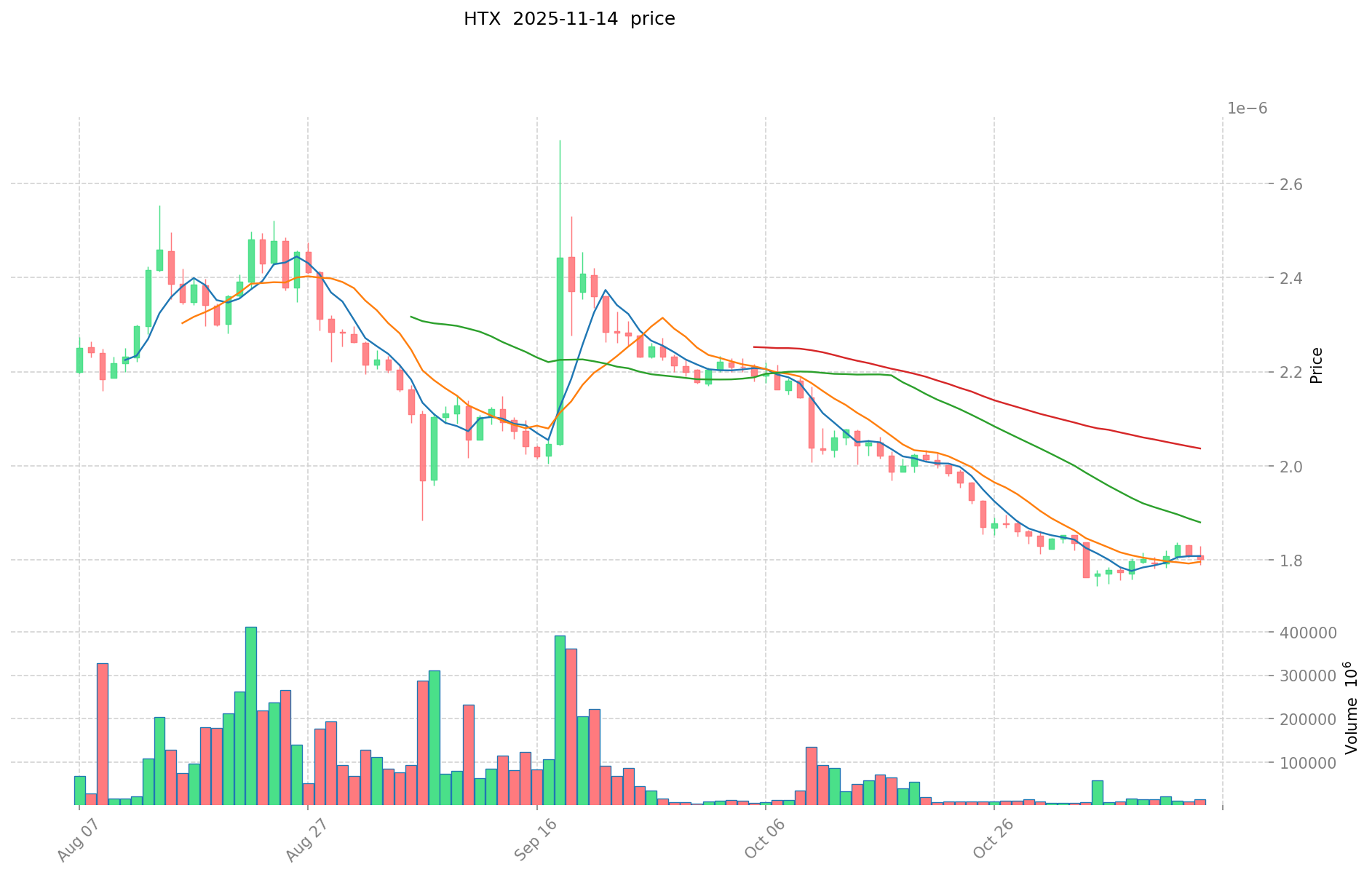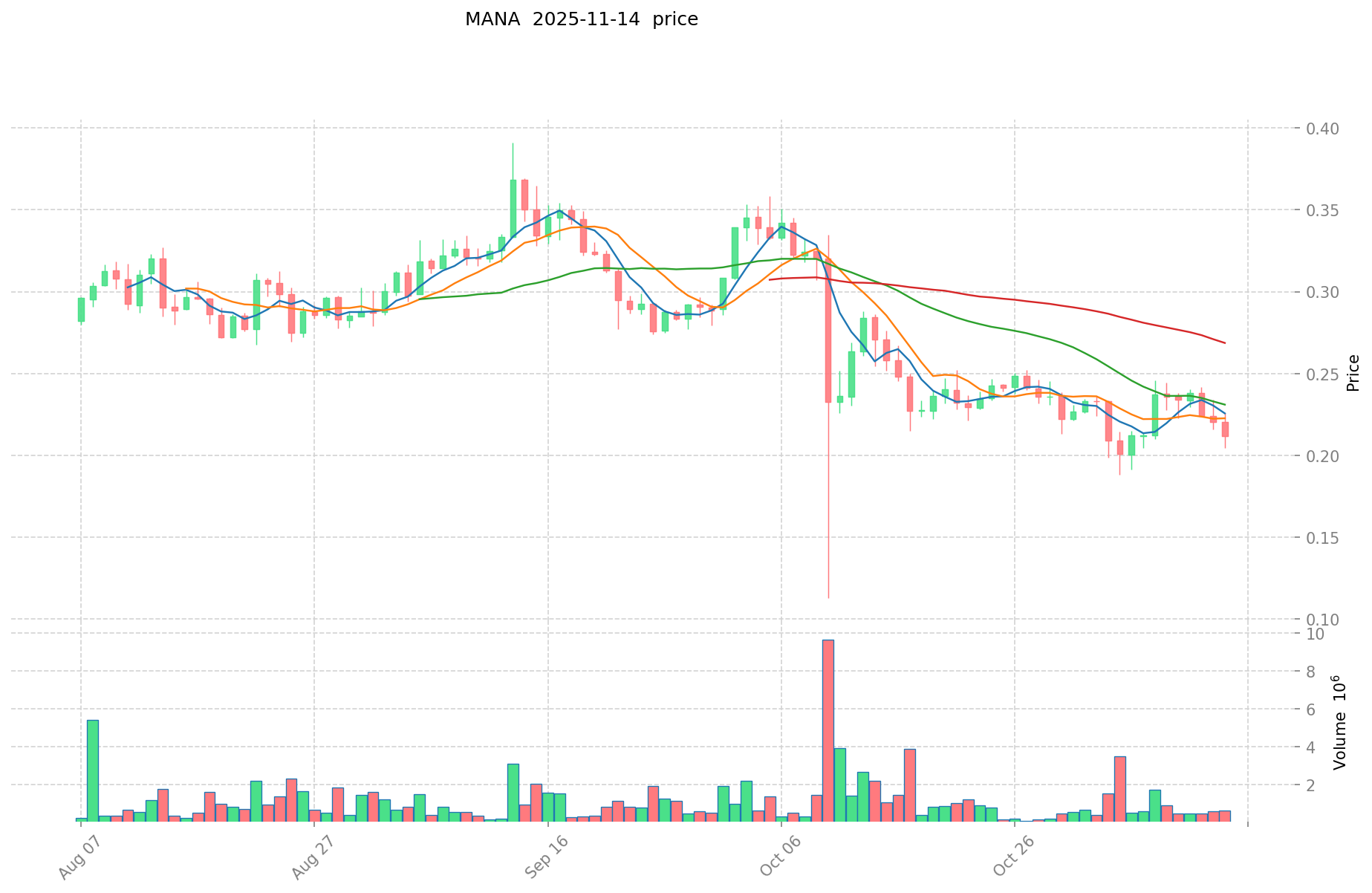HTX vs MANA: The Battle for Dominance in the Metaverse Economy
Introduction: Investment Comparison of HTX vs MANA
In the cryptocurrency market, the comparison between HTX and MANA has always been an unavoidable topic for investors. The two not only show significant differences in market cap ranking, application scenarios, and price performance, but also represent different positions in crypto assets.
HTX (HTX): Since its launch, it has gained market recognition for its role as the largest contributor to ecosystem liquidity in the HTX DAO ecosystem.
MANA (MANA): Launched in 2017, it has been hailed as a virtual world platform based on blockchain, aiming to solve the problem of platform providers earning intermediate profits for decentralized open-source projects.
This article will comprehensively analyze the investment value comparison between HTX and MANA, focusing on historical price trends, supply mechanisms, institutional adoption, technological ecosystems, and future predictions, attempting to answer the question investors care about most:
"Which is the better buy right now?"
I. Price History Comparison and Current Market Status
HTX and MANA Historical Price Trends
- 2024: HTX reached its all-time high of $0.0000040025 on December 4, 2024.
- 2024: MANA experienced a significant decline, with its price dropping to $0.21 by November 2025.
- Comparative analysis: In the recent market cycle, HTX dropped from its all-time high of $0.0000040025 to a low of $0.00000029 on February 2, 2024, while MANA declined from its all-time high of $5.85 (reached on November 25, 2021) to its current price of $0.21.
Current Market Situation (2025-11-15)
- HTX current price: $0.0000018048
- MANA current price: $0.21
- 24-hour trading volume: HTX $38,091.35 vs MANA $192,662.11
- Market Sentiment Index (Fear & Greed Index): 16 (Extreme Fear)
Click to view real-time prices:
- View HTX current price Market Price
- View MANA current price Market Price


II. Core Factors Affecting the Investment Value of HTX vs MANA
Supply Mechanism Comparison (Tokenomics)
- HTX: Limited supply of 310 million tokens with regular token burns reducing circulating supply.
- MANA: Fixed maximum supply of 2.8 billion MANA tokens, with approximately 1.8 billion in circulation.
- 📌 Historical pattern: Deflationary mechanisms like HTX's token burns tend to create upward price pressure when demand increases, while MANA's fixed supply creates scarcity in relation to metaverse land demand.
Institutional Adoption and Market Applications
- Institutional holdings: MANA has attracted more institutional interest through metaverse land investments and virtual reality experiences.
- Enterprise adoption: HTX is primarily used within the Huobi exchange ecosystem, while MANA has broader applications in virtual real estate, digital art galleries, and interactive experiences.
- Regulatory attitudes: Both face varying regulatory scrutiny, with HTX more exposed to changes in Asian regulatory environments, while MANA faces metaverse-specific regulatory developments.
Technical Development and Ecosystem Building
- HTX technical upgrades: Integration with Huobi's global exchange ecosystem and cross-chain functionalities.
- MANA technical development: Continuous improvements to the Decentraland platform, enhanced graphics rendering, and virtual experience capabilities.
- Ecosystem comparison: MANA has established a stronger position in NFTs and virtual experiences, while HTX focuses more on exchange utility and financial services.
Macroeconomic Factors and Market Cycles
- Inflation environment performance: Both assets have shown volatility during inflationary periods, with neither demonstrating consistent inflation-hedge properties.
- Macroeconomic monetary policy: Both tokens show sensitivity to Federal Reserve decisions and interest rate changes, with risk-asset correlations.
- Geopolitical factors: HTX may be more vulnerable to Asian regulatory changes, while MANA's decentralized metaverse focus makes it somewhat less susceptible to regional regulatory actions.
III. 2025-2030 Price Prediction: HTX vs MANA
Short-term Prediction (2025)
- HTX: Conservative $0.000001552128 - $0.0000018048 | Optimistic $0.0000018048 - $0.000002598912
- MANA: Conservative $0.201696 - $0.2101 | Optimistic $0.2101 - $0.256322
Mid-term Prediction (2027)
- HTX may enter a growth phase, with estimated price range $0.000002209562496 - $0.00000324069166
- MANA may enter a stable phase, with estimated price range $0.1493716455 - $0.328127877
- Key drivers: Institutional capital inflow, ETFs, ecosystem development
Long-term Prediction (2030)
- HTX: Base scenario $0.000001876018529 - $0.000003350033088 | Optimistic scenario $0.000003350033088 - $0.000003584535404
- MANA: Base scenario $0.183198087551729 - $0.315858771640912 | Optimistic scenario $0.315858771640912 - $0.43272651714805
Disclaimer: The information provided is for informational purposes only and should not be considered as financial advice. Cryptocurrency markets are highly volatile and unpredictable. Always conduct your own research before making any investment decisions.
HTX:
| 年份 | 预测最高价 | 预测平均价格 | 预测最低价 | 涨跌幅 |
|---|---|---|---|---|
| 2025 | 0.000002598912 | 0.0000018048 | 0.000001552128 | 0 |
| 2026 | 0.00000270828288 | 0.000002201856 | 0.00000118900224 | 22 |
| 2027 | 0.00000324069166 | 0.00000245506944 | 0.000002209562496 | 36 |
| 2028 | 0.000003502893076 | 0.00000284788055 | 0.000002677007717 | 57 |
| 2029 | 0.000003524679363 | 0.000003175386813 | 0.000001809970483 | 75 |
| 2030 | 0.000003584535404 | 0.000003350033088 | 0.000001876018529 | 85 |
MANA:
| 年份 | 预测最高价 | 预测平均价格 | 预测最低价 | 涨跌幅 |
|---|---|---|---|---|
| 2025 | 0.256322 | 0.2101 | 0.201696 | 0 |
| 2026 | 0.2565321 | 0.233211 | 0.14225871 | 10 |
| 2027 | 0.328127877 | 0.24487155 | 0.1493716455 | 16 |
| 2028 | 0.312284687715 | 0.2864997135 | 0.151844848155 | 36 |
| 2029 | 0.332325342674325 | 0.2993922006075 | 0.182629242370575 | 42 |
| 2030 | 0.43272651714805 | 0.315858771640912 | 0.183198087551729 | 49 |
IV. Investment Strategy Comparison: HTX vs MANA
Long-term vs Short-term Investment Strategies
- HTX: Suitable for investors focused on exchange ecosystems and potential for rapid growth
- MANA: Suitable for investors interested in metaverse technology and virtual real estate
Risk Management and Asset Allocation
- Conservative investors: HTX: 20% vs MANA: 80%
- Aggressive investors: HTX: 60% vs MANA: 40%
- Hedging tools: Stablecoin allocation, options, cross-currency portfolios
V. Potential Risk Comparison
Market Risks
- HTX: High volatility due to exchange-related news and regulatory changes
- MANA: Susceptibility to overall crypto market trends and metaverse adoption rates
Technical Risks
- HTX: Scalability, network stability
- MANA: Platform performance, user experience issues
Regulatory Risks
- Global regulatory policies have different impacts on both, with HTX potentially more affected by Asian regulations and MANA by metaverse-specific regulations
VI. Conclusion: Which Is the Better Buy?
📌 Investment Value Summary:
- HTX advantages: Strong exchange ecosystem integration, regular token burns
- MANA advantages: Established position in metaverse and NFTs, broader application scenarios
✅ Investment Advice:
- New investors: Consider a smaller allocation to MANA as an entry to metaverse investments
- Experienced investors: Balanced portfolio with both HTX and MANA, adjusting based on market trends
- Institutional investors: Focus on MANA for metaverse exposure, consider HTX for exchange-related strategies
⚠️ Risk Warning: The cryptocurrency market is highly volatile, and this article does not constitute investment advice. None
VII. FAQ
Q1: What are the main differences between HTX and MANA? A: HTX is primarily used within the Huobi exchange ecosystem and focuses on financial services, while MANA is a virtual world platform based on blockchain, used for virtual real estate, digital art galleries, and interactive experiences in the metaverse.
Q2: Which token has shown better price performance recently? A: Based on the provided data, HTX has shown better recent price performance, reaching an all-time high of $0.0000040025 on December 4, 2024, while MANA has experienced a significant decline to $0.21 by November 2025.
Q3: How do the supply mechanisms of HTX and MANA differ? A: HTX has a limited supply of 310 million tokens with regular token burns reducing circulating supply, creating a deflationary mechanism. MANA has a fixed maximum supply of 2.8 billion tokens, with approximately 1.8 billion in circulation.
Q4: Which token is more suitable for long-term investment? A: MANA may be more suitable for long-term investment due to its established position in the metaverse and broader application scenarios. However, investors should consider their risk tolerance and conduct thorough research before making any investment decisions.
Q5: What are the main risks associated with investing in HTX and MANA? A: HTX faces high volatility due to exchange-related news and regulatory changes, especially in Asian markets. MANA is susceptible to overall crypto market trends and metaverse adoption rates. Both tokens face technical risks such as scalability and platform performance issues.
Q6: How might institutional adoption affect the future value of HTX and MANA? A: MANA has attracted more institutional interest through metaverse land investments and virtual reality experiences, which could potentially drive its value in the long term. HTX's institutional adoption is more closely tied to the performance and adoption of the Huobi exchange ecosystem.
Q7: What factors should be considered when deciding between HTX and MANA for investment? A: Investors should consider their investment goals, risk tolerance, belief in the potential of exchange ecosystems versus metaverse technology, regulatory environments, and the overall crypto market trends. Additionally, they should assess the technical development and ecosystem building efforts of both projects.
Share
Content